|
The heart, which is about the size of a human fist,
is the body's largest, strongest, and most important muscle.
The heart continuously pumps blood through the body, helps
regulate and prolong health, and controls the flow (circulation)
of blood to the lungs, organs, muscles, and tissues in
the body.

Heart disease is a leading cause of debilitation and
death worldwide in men and women over age sixty-five.
In many countries heart disease is viewed as a "second
epidemic," replacing infectious diseases as the
leading cause of death
"We don't usually worry too much about heart disease risk until a person
is in middle age because it's rare to have a heart attack in young adulthood," Mark
J. Plecher, M.D., M.P.H., an associate professor of Epidemiology & Biostatistics
and of Medicine at the University of California, San Francisco, was quoted as
saying. "However, our evidence shows that young adulthood is an important
time because lasting damage already starts to accumulate at this age."
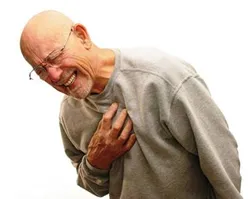
One sign of heart disease is angina, the pain that
occurs when a blood vessel to the heart is narrowed
and the blood supply is reduced. You may feel pain
or discomfort in your chest, shoulders, arms, jaw,
or back, especially when you exercise. The pain may
go away when you rest or take angina medicine. Angina
does not cause permanent damage to the heart muscle,
but if you have angina, your chance of having a heart
attack increases. Source |
The signs and symptoms of a heart attack
change for each person and often go unrecognized. Serious
heart attack symptoms (even chest pain and shortness
of breath) are sometimes dismissed, says Curtis Rimmerman,
M.D., M.B.A., F.A.C.C, Gus P. Karos Chair in Clinical
Cardiovascular Medicine at Cleveland Clinic in Cleveland,
Ohio In terms of chest discomfort, most health and medical
sources use the term "chest pain," but in his
book The Cleveland Clinic Guide to Heart Attacks (Kaplan
Publishing, May 2009), Rimmerman says the word "discomfort" is
more accurate: "If you ask a patient who is experiencing
a coronary artery event, 'Are you experiencing pain?'
the answer may be no. But if you ask the same patient,
'Are you experiencing discomfort in or around your chest?'
the answer may be yes."

Women may not have chest pain but may be more
likely to have shortness of breath, nausea, or
back and jaw pain. If you have symptoms of a heart
attack, call 911 right away. Treatment is most
effective if given within an hour of a heart attack.
Early treatment can prevent permanent damage to
the heart.
Middle-aged women have historically had a lower
overall risk of heart events and stroke than
men of a similar age, according to background
information in one of the articles. However,
a recent report showing higher stroke rates among
women than men in a sample representative of
the U.S. population appeared to reveal a new
phenomenon and raised the question of whether
heart disease or heart attack were also becoming
more prevalent among women.Source |
Having diabetes or pre-diabetes puts
you at increased risk for heart disease and stroke
Primary cause: Blood clots or blocked
arteries due to coronary artery disease.
How arteries get blocked: The coronary arteries
supply the heart with oxygen-rich blood. Over time,
the arteries can become lined with plaque because of:
•poor diet
• sedentary lifestyle
• smoking
• high cholesterol
• high blood pressure
• hereditary factors
The role of plaque: Arterial plaque
can become so thick that it severely restricts blood
flow to the heart. Plaque can also rupture, triggering
the formation of a blood clot that can block blood flow.

High Cholesterol,
and High Triglyceride
Cholesterol and triglycerides are two forms of lipid,
or fat. Both cholesterol and triglycerides are necessary
for life itself. Cholesterol is necessary, among other
things, for building cell membranes and for making several
essential hormones. Triglycerides, which are chains of
high-energy fatty acids, provide much of the energy needed
for cells to function.

Your body uses it to make hormones, vitamin D, and substances
that aid digestion. But that doesn't mean you should
make a run for the turkey bacon. That's because your
body makes all the cholesterol it needs on its own, without
any extra-fatty foods eaten by you.
Dietary cholesterol and triglycerides mainly come from
eating meats and dairy products. These dietary lipids
are absorbed through the gut,and then are delivered through
the bloodstream to the liver, where they are processed.
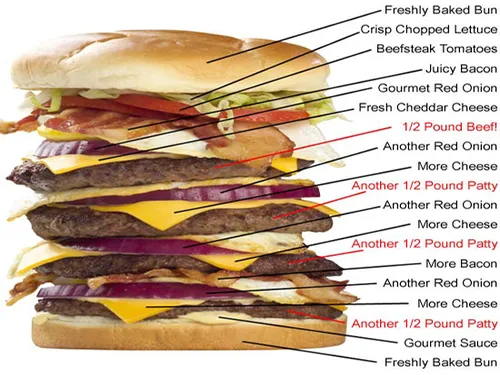 |
Heart
disease is the number one health problem in the
United States today, and according to the American
Heart Association, it is the single leading cause
of death. Most heart disease is diet-related—caused
by diets high in animal products.
Meat, eggs, and dairy products are high in cholesterol
and saturated fat. (No plant food in the world
contains any cholesterol.) As these fatty substances
build up inside the walls of arteries as “plaque,” blood
flow to all areas of the body is impeded. This
artery damage is called “atherosclerosis.” When
too little blood reaches various regions of the
body, normal bodily functions are impaired, setting
people up for a number of diseases, most notably
heart disease. |
The liver then packages the cholesterol
and triglycerides, along with special proteins, into
tiny spheres called lipoproteins. The lipoproteins are
released into the circulation, and are delivered to the
cells of the body. The cells remove the needed cholesterol
and triglycerides from the lipoproteins, as they are
needed.
More than half of adults have too much cholesterol flowing
around in their bloodstreams, a problem that, frighteningly
enough, often carries back to their childhoods. Once
your total cholesterol reaches 200 milligrams per deciliter,
your risk of heart disease increases. And with it, your
risk of death from heart disease -- the No. 1 killer
of women.
A triglyceride is a type of fat. Our blood also has
triglyceride that circulates in lipoproteins. The triglyceride
is stored as fat in our body. As most of the fats in
food are triglycerides, the food we eat affects blood
level of triglycerides. When we eat fat, blood triglyceride
increases 2-4 times and reaches to its maximum value
in about 5 hours after the meal. Our liver also synthesizes
triglyceride. The triglyceride concentrations in the
blood vary considerably throughout the day, depending
upon how much fat is eaten and how fast the body removes
fat from the blood. Our bodies make triglycerides from
excess carbohydrate in our diet.
High fat Foods and Weight
Gain: As your weight increases, triglyceride
levels also increase. One
of the causes of high triglycerides is excess
calories, especially that derived from sugar/alcohol.
Alcohol
not only increases your liver’s production
cleared from the body, but also plays a part
in reducing the amount of fat that is being cleared
from your blood. Further, all high fat foods-
like
red meat, dairy products, organ meat, high sugar
diet- increase triglyceride levels in the body.
What are triglycerides- wherever fat is found
around the body, be sure that it is one of the
major causes
of high triglyceride levels. |
Cholesterol and triglycerides are necessary for our
life. The triglycerides provide the fuel needed for body
cells to function.
While the association between triglycerides and the
risk of heart disease has not been as clear as it is
for cholesterol, in recent years, several studies have
established that people with elevated levels of triglycerides
are indeed at increased risk. Also, elevated triglyceride
levels are very often strongly associated with other
important risk factors, including low levels of HDH cholesterol,
obesity, insulin resistance, diabetes, and a tendency
toward excessive blood clotting.

Luckily, it's never too late to make
changes that can effectively help health problems
LASER
BLOOD CLEANSER
Reported Uses:
Treatment: high blood fat, high blood glutinosity, hypertension, coronary
heart problems, angina, myocardial infarction, atheroma, etc.
Recovering: the sequelas of cardiovascular & cerebrovascular diseases,
such as, aphemia, hemiplegia, anaesthesia, etc.
Improvement: headache, dizzy , heart-throb,breathe hard, weak, etc.
Modulation: endocrinopathy, such as, diabetes, etc.
Diseases of nervous system and endocrine system: Diseases
of respiratory system: allergic rhinitis, pneumal infection,
etc
Diseases of digestive system: gastric ulcer, chronic gastroenteritis
Bacteria, Parasites etc
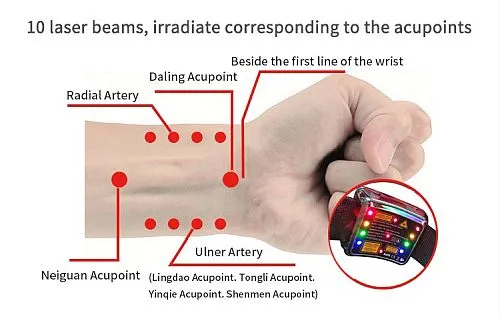
Every once in
a while a technology is introduced that transforms
the landscape of health care. Low Level Laser
Therapy is a perfect example of such a development.
It is well accepted, painless and, bottom
line, it gets results.
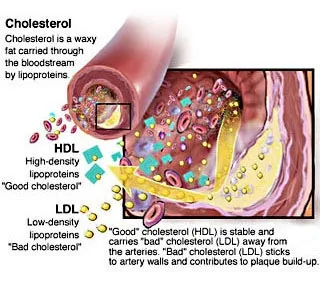
Low Level
Laser Therapy involves
applying a "low" energy or "low
level" laser to tissue in order
to stimulate cellular processes and
enhance biochemical reactions.
Low level laser therapy has been shown
to treat a wide range of disorders which,
at first, seem to have nothing or very
little in common.
For example, LLLT can
accelerate wound and burn healing, reduce pain in different
limbs all over the body, improve the condition of patients
after a stroke, help in treatment of diabetic angiopathy,
and reduce stiffness and inflammation.
The physiological effects of laser light
at low intensity are not completely understood,
but what is known is that it has three
main effects:
• biostimulation/tissue regeneration
• anti-inflammatory
Inflammation is not complicated --
it is quite simply your body's natural
defence to a foreign invader such as
a bacteria, toxin or virus. The cycle
of inflammation is perfect in how it
protects your body from these bacterial
and viral invaders. However, if we
chronically expose the body to injury
by toxins or foods the human body was
never designed to process,a condition
occurs called chronic inflammation. Chronic inflammation is
just as harmful as acute inflammation
is beneficial. Source |
• analgesic
(pain relieving)
One of the
most important effects of LLLT is
that it speeds up Adenosine triphosphate
(ATP) production, by increasing physical
and chemical changes at the cellular
level, and enabling the cells deprived
of blood flow in the damaged tissue
to heal and to attain their normal
functions.
ATP is an organic compound composed of adenine, the sugar
ribose, and three phosphate groups. It captures chemical
energy obtained from the breakdown of food molecules and
releases it to fuel other cellular processes, serving as
the major energy source within the cell. Think of it as our
cell's nuclear power plants.
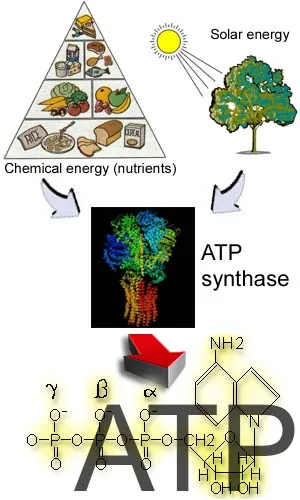
ATP is present in every cell, and essentially
all the physiological mechanisms that require
energy for operation obtain it directly
from stored ATP.
When energy is needed by the cell, it
is converted from storage molecules into
ATP. ATP then serves as a shuttle, delivering
energy to places within the cell where
energy-consuming activities are taking
place.
Outside the cell, ATP has been found to
act as a neurotransmitter. ATP receptors
are widespread through the body. On its
own it is known to have effects in the
arteries, intestines, lungs, and bladder.
It is also often released in tandem with
other neurotransmitters, perhaps to add
chemical stability.
Low-intensity radiation in the red and
infrared spectral ranges induces certain
changes in the body,these play an important
role in achieving the clinical therapeutic
effects of this device.
The most important of these effects is improved blood micro-circulation
, which further enhances the therapeutic effect of the low-level
laser therapy device. The biological effect is due to the
dilating of small blood vessels, a decrease in the adhesive
ability of blood cells, and aiding in the formation of new
micro-vessels.
In addition, low-intensity radiation
has a positive influence on the quantity
and quality of the immune system, leading
to increased destruction of bacteria.
Each organ of the body
has its own rate of vibration. The first,
third and fifth notes on the musical octave
...vibrate in harmony. The first, second
and third ...do not vibrate in harmony.
If the string of the fifth note on the
scale is out of tune, there will be inharmony
...every time this note is struck. Just
so ...there is health inharmony —when
any one of the organs is out of tune. As
the fifth string on the piano, when out
of tune must be brought up to pitch, reinstated
in its proper vibration, just so ...must
the physical organ —out of tune— be
reinstated, brought up to the proper vibration.
The vital current that carries the life
principle must be restored, built up, and
a proper equilibrium (vibration) ...must
be reestablished.
 |
Low cell voltage Damaged
Receptors,,
The 70 trillion cells in your body
are like little wet cell batteries
that operate ideally at a voltage
of around 70 millivolts. The cell
membrane acts like a one-way rectifier
that converts the earth's magnetic
pulse into electrical potential energy,
which "charge's your cells".
This energy drives cell metabolism
and helps to enhance oxygenation,
ATP production and overall absorption
of nutrition and essential elements
into the cell and removal of wastes
out of the cell.
Without this energy, the cell voltage
weakens and disease and illness sets
in.
More
|
Laser
Blood Cleaner
Used in Asia to Treat And Prevent
Vascular Diseases
Laser Blood Cleaner, which is
used in Asia to help with cardiovascular & encephalovascular
disease, diabetes, and any other diseases
related to blood.
Feature of the Laser Blood Cleaner
1. High-tech device, Class 2 .
Laser Blood Cleaner uses low strength laser radiation of
650nm wavelength, which can be absorbed by blood through
nasal mucous membrane.
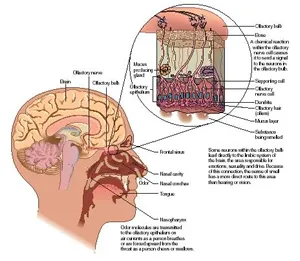
3. Low strength laser of 650nm wavelength
absorbed by blood can make the extra fat
wrapping around the RBC(red blood cell)
lower.
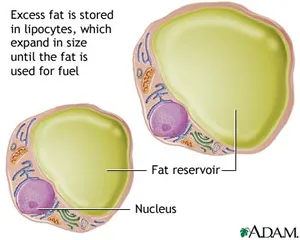
As the result the RBC(red blood cell)
is released

!. So the electriferous power of RBC
(red blood cell) recovers, and its absorption
of Oxygen improves. The supply of oxygen
in the body improves at the same time,
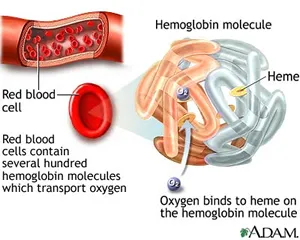
4. Laser Blood Cleaner with low strength
laser of 650nm walvelength can active the
sympathetic nerve and the vice-sympathetic
nerve fibres, so the circulation of blood
in the brain and all over the body will
be improved .
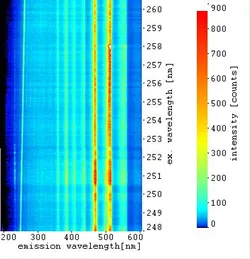
5. Besides, Low strength laser of 650nm
wavelength can correct the abnormal metabolism
of fat, keeping the balance of fat level
and the proportion of cholesterol and lecithoid
(resembling lecithin) So, with the function
of Laser Blood Cleaner, cardiovascular & encephalovascular
irregularities, diabetes, and any other
dis-eases related to blood may be helped.
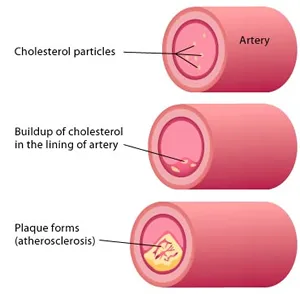
Technical Stuff
Laser Blood Cleaner applies
low-intensity laser with the
wavelength of 650nm to irradiate
the nasal cavity and inject monochromatic
photons of low-intensity into
blood to increase the amount
of enzymes in blood used for
dissolving the fat layer and
cholesterol such as lipoproteinase
,cholesterol transferase etc,
there fore, the fat layer wrapping
around the erythrocyte is shucked
out of, thereby, the ventilation
ability of the erythrocyte is
recovered and the oxygen-carrying
function is improved.
Meanwhile, the negative charges on erythrocyte surface
are recovered because the surface layer wrapping around
the erythrocyte is shucked off, thus ,the repulsive
force between each two erythrocytes increases, so the
erythrocytes that originally accumulated in mass. disperse
apart. This can also change the molecule configuration
of the protein in blood such as enzyme and other functional
proteins, then, a series of biological effects will
occur in the body through photochemical reaction of
energy exchange. After the nasal cavity is irradiated
on by laser, the blood vessels of nasal mucous membrane
will constrict and expand due to the stimulation to
the sympathetic and parasympathetic nerves, thus, leading
to the improvement of encephalic blood circulation
and that of the whole body reflectively


Pictures
Taken With a Darkfield Microscope
More |
Laser
Blasts Viruses In Blood
ScienceDaily (Sep. 5, 2007) — A father-son research
team working from separate laboratory benches across
the country has discovered a new use for lasers — zapping
viruses out of blood. The technique, which holds promise
for disinfecting blood for transfusions, uses a low-power
laser beam with a pulse lasting just fractions of a second.
Johns Hopkins University student Shaw-Wei David
Tsen says it was during a stroll in the park
with his father that the idea was born. Tsen,
an immunology researcher in the laboratory of
T.C. Wu at Hopkins’ Kimmel Cancer Center,
sought a new method to rid isolated blood of
dangerous pathogens, including the viruses HIV
and hepatitis C. He says current techniques using
UV irradiation and radioisotopes can leave a
trail of mutated or damaged blood components.
Using ultrasonic vibrations to destroy viruses
was one possibility, but his father, Kong-Thon
Tsen, a laser expert at Arizona State University,
had a better idea: Lasers, unlike ultrasound,
can penetrate energy-absorbing water surrounding
the viruses and directly vibrate the pathogen
itself.
The researchers aimed a low-power laser with
a pulse lasting 100 femtoseconds (10-13 second)
into glass tubes containing saline-diluted viruses
that infect bacteria, also known as bacteriophages.
The amount of infectious virus within each cube
plummeted 100- to 1000-fold after the laser treatment. “I
had to repeat the experiment several times to
convince myself that the laser worked this well,” says
the younger Tsen.
His laser is different from those emitting a
continuous beam of visible light. “Our
laser repeatedly sends a rapid pulse of light
and then relaxes, allowing the solution surrounding
the virus to cool off,” Tsen says. “This
significantly reduces heat damage to normal blood
components.”
Building on the idea that vibration wrecks a
virus’ outer shell, the scientists found
that their low-power laser selectively destroys
viruses and spares normal human cells around
them, while stronger beams kill almost everything.
Father and son speculate that laser vibrations
could destroy drug-resistant and -sensitive viruses
alike.
Wu says that the technique his student developed “could
potentially be used to control communicable diseases
by giving infusions of laser-treated blood products.”
The scientists published their results in the
July 13 issue of the Journal of Physics: Condensed
Matter. They will continue their studies using
different viruses.
Says Wu, “We believe this work on bacterial
viruses is promising, but the real test will
be with more serious pathogens like HIV and hepatitis.”
The National Science Foundation funded the research.
Additional collaborators include Chih-Long Chang
and Chien-Fu Hung from Johns Hopkins and Juliann
G. Kiang from the Uniformed Services University
of the Health Sciences.
Source |
1. Laser Blood Cleaner has low strength
laser radiation of 650nm wavelength, which
can be absorbed by blood through nasal
mucous membrane.
2. Low strength laser of 650nm wavelength,
is on the top of the HB (Hemoglobin
) spectral analysis, which can be absorbed
strongly by HB.
3. Low strength laser of 650nm wavelength
can make the extra fat wrapping around
the RBC (ref blood cell) lower.Cardiovascular
and Encephalovascular irregularties sometimes
caused by lack of blood supply can be offset.
4. With the Declination of the exact fat,
the combinative Oxygen of RBC will be increase
deeply. The supply of Oxygen in the body
is improved at the same time..
5. Low strength laser of 650nm wavelength
can correct the abnormal metabolism of
fat, keeping the balance of fat level and
the proportion of cholesterol.
6. Besides, it can active the sympathetic
nerve and the vice-sympathetic nerve fibers, so the circulation of blood in the brain
and all over the body will be improved.
The role of the sympathetic nervous
system has the following main aspects:
(1) the role of the circulatory system: the skin and
abdominal organs of rhabdomyosarcoma and vascular only
sympathetic to the domination, coronary circulation and
cerebral circulation of the blood vessels are accepted
at the same time sympathetic and the two vice sympathetic
nerve fibers, it can stimulate the sympathetic general
The peripheral artery contraction, and in the removal
of sympathetic after expansion will enable peripheral
artery. Treatment of peripheral vascular disease, sympathetic
with the purposes of, or as a basis. |
More
information here
Four
Color 10 Beam 3 in 1Wrist Laser
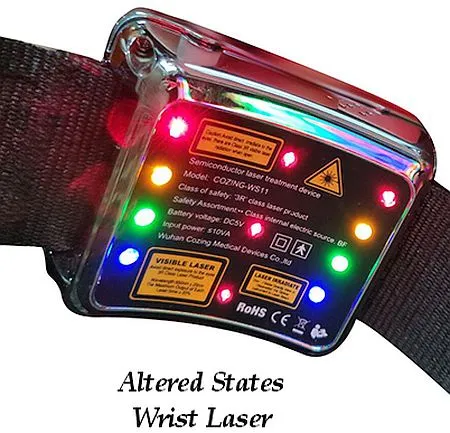
Red
Laser Activate Metabolism:
Lower Blood Pressure and Improve Blood
Flow
An unhealthy lifestyle enhance the possibility that cholesterol and other blood
fats build up on vessel walls and thus impair the oxygen and nutrient supply
to our organs. Laser light activates different enzymes and decomposes redundant
fat in the bloodstream. It increases the oxygen amount in the blood, boosts
metabolism and enhances the process of lipid peroxidation to reduce cholesterol
in the vessels.
Effects of
Green Light and Yellow Light
Yellow
light promotes serotonin
and vitamin D metabolism.Yellow
light stimulates the mitochondrial
respiratory chain at complex III
(cytochrome) and acts strongly
detoxifying and anti-depressive.
Green light binds
to hemoglobin, the ferrous blood compound in
the red blood cells. It improves the function,
behavior and cell elasticity of those cells
as well as the oxygen supply.other effects:
improved oxygen affinity, decreases in lactic
acid, reduced blood viscosity, improved blood
flow, activation of reparative,
Effects of Blue
light Blue light stimulates
the first complex of the respiratory chain
(NADH dehydrogenase). Effects: anti-inflammatory,
enhances NO production, activates telomerase
(Anti-Aging!) By increasing the activity
of fibroblasts blue light optimizes wound
healing and improves the oxygen utilization
in the tissue.
|
1. First Option: Wear
the laser watch
First Step: Wear the main machine
on the inner side of the left wrist,
as shown in the diagram, so as to ensure
the laser irradiates radial artery
and neiguan acupoint precisely; and
then fasten the wrist strap.

|
| |
|
 |
2. Second Option:: Use
the ear probe
Wear the ear probe in the ear, insert
the Ear probe accessory in the topside
accessory plug of laser watch, (Reported
by many to be very helpful with Tinnitus) |
| |
|
 |
3. Third Option:: Nasal
probe
When changing tratement from ear,
to nose The nasal probe uses the same
accessory output plug as the ear probe.
avoid
eye contact of laser. |
Conclusions: In summary, more
than 25 years of experience of using laser
energy at 630-640 nm has shown that this waveband
directly influences the parameters of all cells
in the blood, blood plasma, the coagulation
process and all the structural components of
the vascular wall. Additionally, ILBI directly
or indirectly affects the cells of the immune
system, hormones, and exchange processes in
an organism, thereby not only improving the
function of the vascular system, but also the
other systems of an organism. It
can finally lead to lower the incidence and
number of vascular diseases, and indirectly
to the reduction of the number of diseases
in other organs and even systemically, thus
helping to prolong the lifespan. Source

Four
Color 10 Beam 3 in 1 Wrist Laser
Laser energy at 630-650
nanometers is arguably the most effective
for irradiation of blood and the vascular
wall. Photons at these wavelengths
are absorbed by oxygen, improve microcirculation,
can change the viscosity of the blood
and affect vascular endothelium, plus
Smash viruses.
For general use, they
suggested 30min Two to three times
a day. (Wear only ON left wrist)
 |
Four
Color 10 Beam 3 in 1 Wrist
Laser
Power source
Lithium battery
Laser
probe for Ear 650nm
laser diode Max 5mW for
each laser diode
Laser
probe for nose 650nm
laser diode Max 5mW for each
laser diode
Laser
for
wrist 650nm
laser
diode
(Red,
plus
Blue,
Green,
Yellow
laser)
USB charging
cable
Instruction manual

|
|
Standard fda required warning
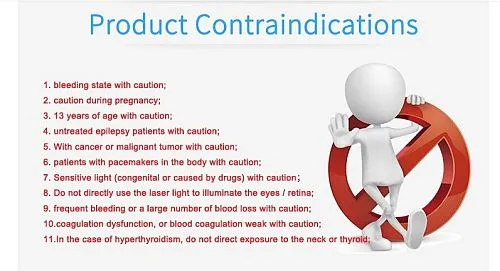
Sadly The web page authors after 39 years
of working with alternative health in our Free
alternative clinic,are not allowed to endorse
the accuracy or reliability of any of the information,
content or guidelines (collectively, the "Materials")
contained on, distributed through, or linked,
downloaded or accessed from these links. You
hereby acknowledge that any reliance upon any
Materials shall be at your sole risk.
Caution
1)Not suitable for the following groups:cancer patient,pregnancy ,patient with
hemorrhagic disease.
2)Children shall only use the instrument under the direction of their parents.
3) The elder patients and sensitive patients must accept the low-power and
short treatment at the beginning,the rate of work could be increased as the
body adjusts.
Those of You interested in the
matter of laser blood irradiation are welcome
to check out the following links that will
help you learn more. For specialists, we recommend
the book written by
Gejnic,
Moskvin, Achilov: Intravenal laser blood
irradiation, which is a comprehensive
source of information you won`t find anywhere
else. A part of it is published on Russian
servers. We have acquired information from
many sources from this article. We focus
Your attention to S.V.Moskvin, a
significant specialist in this field and
the author of the article published on the
Medprosvet website. You can find more information
on the websites below.
Similar
Articles for PMID: 25941421
Source
•http://www.medprosvet.ru/articles/?content=article&id=24
• http://www.matrixlaser.ru/?page=media&act=pubs&subact=6
• http://www.matrix-mustang.ru/?page=products&act=laser&subact=VLOK-405
• www.egla.de
• www.webermedical.com
• www.walt.nu
• www.laserpartner.cz
• www.laserpartner.org
• www.laser.nu
Ing. František Kokoš, YALONG TRADE s.r.o., 10.6.2009, revised on
26.11.2009.
|

